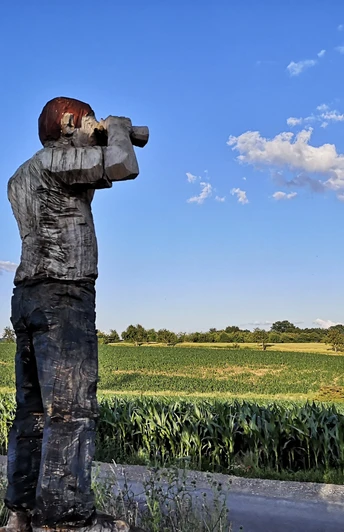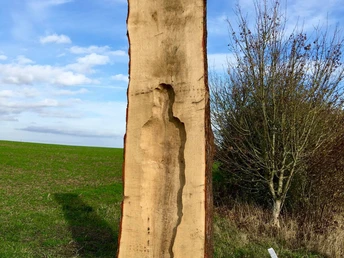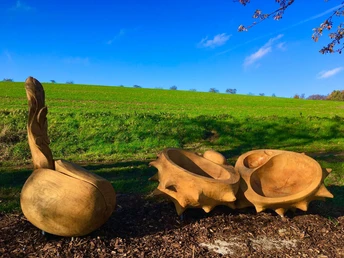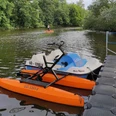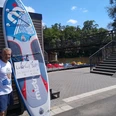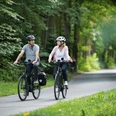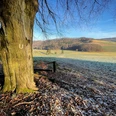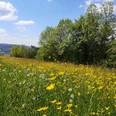- 3:00 h
- 11.00 km
- 330 m
- 330 m
- 220 m
- 400 m
- 180 m
- Start: Marketplace Melsungen, Am Markt 5, 34212 Melsungen
- Destination: Marketplace Melsungen, Am Markt 5, 34212 Melsungen
The ARS NATURA hiking trail combines the current trend for recreation through hiking with art and cultural experiences far away from the confines of a museum.
With the chosen theme "RAUSZEIT" (Get out into nature and take some time out), the 10 works of art along the circular hiking trail pick up on the current zeitgeist for deceleration, time for inner center, reflection and balance:
A library at the edge of the forest and an extraordinary bench where we can look into each other's eyes invite us to linger! A raven little monster eats up all our worries..... The last Hessian wolf shot at the Wolfsstein in the early 19th century has returned in white form to be admired. The hollow form of a man in a tree trunk reminds us of our own origins in nature, and oversized shell halves of a chestnut lead back to its womb. Dandelion (artwork "Gagelagaije") accompanies us on our paths in the landscape all year round. In spring it unfolds its sunny yellow splendor everywhere and serves as a bee pasture and medicinal herb.
We invite you to enjoy nature, come to rest and unwind from the hustle and bustle of everyday life!
*** Supported by the European Agricultural Fund for Rural Development: Here Europe invests in rural areas. Co-financed by the State of Hesse, the development region Mittleres Fuldatal and the Federal Ministry of Food and Agriculture ***
Directions:
The trail, laid out in an irregular figure of eight, starts at the historic Melsung market square and leads first on the Barbarossaweg X8 through Fritzlarer Straße, then through the underpass over the major intersection and then uphill over Schlothberg to Hopfenort, where the 1st work of art awaits you. Now follow the Ars Natura signs past the 2nd work of art to the Siebenstern (Konrad-Hoffmann-Hütte), where the 3rd work of art - the library - is located. From there, the hiking trail circles the Kesselkopf turning left (so please keep right!) and passes the Wolfsstein. At the "Sorgenfresser" it goes left through the forest back to the Siebenstern. Then it goes through field and meadow paths back towards Melsungen, where you can still discover many interesting works of art. Down the Kesselberg you reach the landgrave's castle and further through the pedestrian zone back to the market place with its worth seeing half-timbered town hall.
Explanations of the artworks along the way:
1) Tanja Röder - Pfaffenhofen "Love"
The figure embodies closeness, familiarity, unity in togetherness, elegance. The latter is inherent in each of the artist's works. Smooth surfaces and flowing forms characterize her works. The sensitive wood sculptor succeeds impressively in the interplay between light and shadow, between hard and soft, open and closed. The form is harmonious and balanced, breakthroughs and roundings make their volume light and buoyant. The smooth surfaces tempt the viewer to take a closer look and touch them. Another characteristic of her figures is the missing head, which, however, can easily be imagined by the viewer himself.
2) Cornelia Brader - Memmingen
"Man with binoculars"
Characteristic are the traces of work that characterize the artist's works - originality, robust realism, coupled with balance in proportions and sensitivity in expression. The work is one of the numerous portrait sculptures of the renowned wood sculptor, which she groups under the title "Schnitz Mi".
3) Sandrino Sandinista Sander - Spangenberg
"Melsungen Terminal"
An open library - books can be taken out or brought in. The half-timbered M, here standing for the city of Melsungen, is part of a functional series of letters for which the artist was inspired by the Brothers Grimm dictionary. There are 11 more letter libraries to discover on the ARS NATURA trails so far: B, D, E, F, G, H, K, P, R, W, X. The goal is to gradually complete the alphabet in the form of these open book depots.
4) Michaela Biet - Oberasbach
"Transformation"
"A light gray granite boulder lies like a dormant living being in the landscape. Thousands of years of earth history shaped its outer form. The supposedly rigid material stone receives a new level of meaning through artistic treatment: veins cover the surface, a spine stretches across the center of the stone. The familiar impression of a lying boulder is changed by this artistic intervention and invites one to approach it more closely in order to grasp the work haptically and from all views" (Michaela Biet).
5) Usch Quednau - Köngernheim
"Coming Home"
"On November 18, 1805, the last Hessian free-living wolf was killed by Rittmeister von Wolff at the site of today's Wolfstein on the Kesselkopf. On August 5, 1806, a now weathered 1-meter-high, 0.2-meter-wide Early Classicist sandstone monument with epigram was erected at the downing site to commemorate the last wolf hunt in Hesse for the time being" (Wikipedia). The artist made her own dignified monument in oak to this wolf about 300 meters away. As a white wolf, he is now safe from hunting.
6) Daniela Schönemann - Halle
"Monster, eat my troubles"
"The theme "Rauszeit" brought me to the idea of "rest time", which also means rest from something. He who broods, carries tormenting thoughts with him or reproaches himself cannot find rest. If you pass the sculpture on the hiking trail, you can write everything annoying and negative on a small piece of paper and throw it down the monster's throat. You release the negative thoughts with this symbolic action and create a free space where tranquility can enter." In front of the 'monster' is a small box with a note and pencil. There are also brief instructions there.
7) Meinrad Ladleif - Kassel
"Look me in the eyes"
In the round-shaped designer bench, the view of the landscape can be fantastically enjoyed alone or in pairs. The architect and artist has already designed several unusual benches, always in metal and wood, for the ARS NATURA paths.
8) Andreas Tollhopf - Melsungen
"Close to nature"
The abstracted hollow form of a human being is worked into both cut surfaces marked by the traces of the chain saw, as if a human being had left his imprint there and then left this place. The surface treatment is deliberately rough in order to obtain a lively play of light and shadow. By facing each other at the wayside, the two halves define a space. "Arriving at the place, (the hiker) recognizes the hollow form - the abandoned place - and at the same time feels the desire to lean against the hollow form to become one with the tree again. Man, so connected to and part of nature, has abandoned the tree that gives him life and has distanced himself from nature. On the long journeys to "time out", many people have forgotten that the valuable "time out" to nature, which gives life and energy, can often be so close and can be experienced in a resource-saving and beautiful way" (Andreas Tollhopf).
9) Erich Zimmer -Iffeldorf
"Escaped II"
"A round - Rauszeit" - Round and out and time? ... Departure, new beginning, flourish and grow... With these thoughts I imagined again and again bowls, from which fruits spring. Nuts, peas, beans, chestnuts, horse chestnuts, pod fruits like those of the bread tree. My idea took shape - a broken open horse chestnut. Opened shell halves, which just protectively hold or have released their fruit" (Erich Zimmer).
10) Carola Lantermann - Hauenstein
"Gagelagaije"
"Especially in spring, it is a colorful plant in nature with its flowers! It is a companion throughout the year. When flowering, not only as a bee pasture, it is useful as food in many ways. It also has its place in medicine and folk medicine. There are an infinite number of vernacular names for it, reflecting its importance" (Carola Lantermann).
Good to know
Pavements
Best to visit
Tour information
Barrier-Free
Cultural Interesting
Loop Road
Documents
Author
Tourismusgesellschaft Melsunger Land mbH
Organization
License (master data)
Nearby
